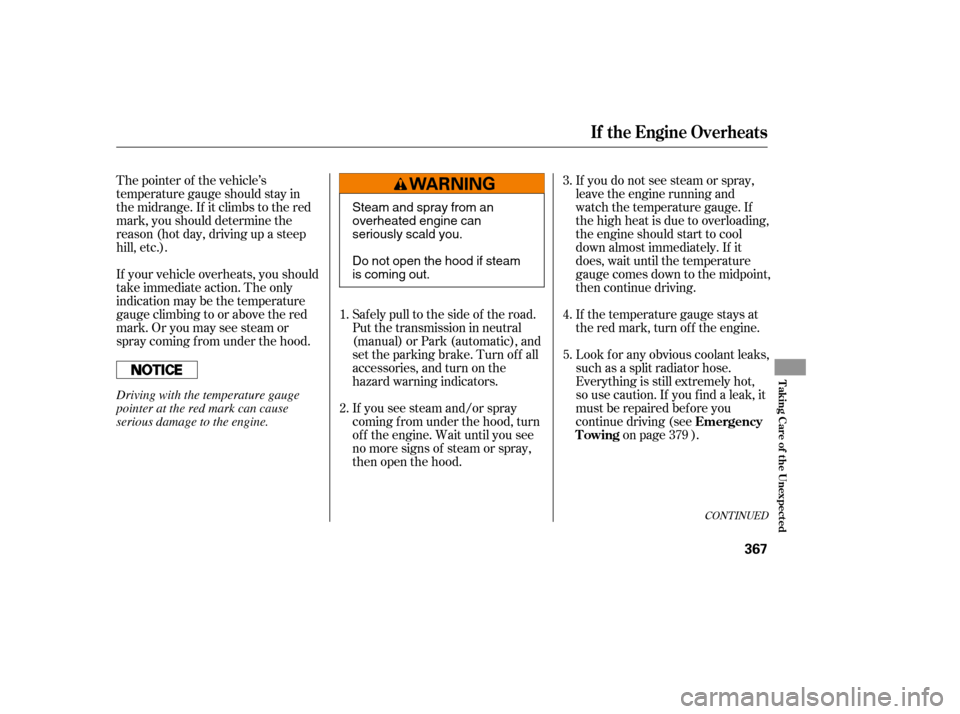Page 389 of 435

If you do not see steam or spray,
leave the engine running and
watch the temperature gauge. If
the high heat is due to overloading,
the engine should start to cool
down almost immediately. If it
does, wait until the temperature
gauge comes down to the midpoint,
then continue driving.
If the temperature gauge stays at
the red mark, turn off the engine.
Look f or any obvious coolant leaks,
such as a split radiator hose.
Everything is still extremely hot,
so use caution. If you f ind a leak, it
must be repaired bef ore you
continue driving (seeon page ).
The pointer of the vehicle’s
temperature gauge should stay in
the midrange. If it climbs to the red
mark, you should determine the
reason (hot day, driving up a steep
hill, etc.).
If your vehicle overheats, you should
take immediate action. The only
indication may be the temperature
gauge climbing to or above the red
mark. Or you may see steam or
spray coming f rom under the hood.
If you see steam and/or spray
coming f rom under the hood, turn
of f the engine. Wait until you see
no more signs of steam or spray,
then open the hood.
Saf ely pull to the side of the road.
Put the transmission in neutral
(manual) or Park (automatic), and
set the parking brake. Turn of f all
accessories, and turn on the
hazard warning indicators.
1. 2. 3. 4. 5.
379
CONT INUED
Emergency
Towing
If theEngineOverheats
T aking Care of t he Unexpect ed
367
Steam and spray from an
overheated engine can
seriously scald you.
Do not open the hood if steam
is coming out.
Driving with the temperature gauge
pointer at the red mark can cause
serious damage to the engine.
�����—�����—�
���y�
�
�����������y���
�)�����������y���������y
Page 390 of 435

Using gloves or a large heavy
cloth, turn the radiator cap
counterclockwise, without pushing
down, to the f irst stop. Af ter the
pressure releases, push down on
the cap, and turn it until it comes
off.Put the radiator cap back on
tightly. Run the engine, and check
the temperature gauge. If it goes
back to the red mark, the engine
needs repair (see
on page ).
If the temperature stays normal,
check the coolant level in the
radiator reserve tank. If it has
gone down, add coolant to the
MAX mark. Put the cap back on
tightly.
If you do not f ind an obvious leak,
check the coolant level in the
radiator reserve tank. Add coolant
if the level is below the MIN mark.
If there was no coolant in the
reserve tank, you may need to add
coolant to the radiator. Let the
engine cool down until the pointer
reaches the middle of the tempera-
ture gauge, or lower, bef ore check-
ing the radiator.
Start the engine, and set the
temperature to maximum heat
(climate control to AUTO at
‘‘ ’’). Add coolant to the
radiator up to the base of the f iller
neck. If you do not have the
proper coolant mixture available,
you can add plain water.
Remember to have the cooling
system drained and ref illed with
the proper mixture as soon as you
can.
7.
6.
8.
9. 10. 11.
379
Emergency
Towing
If theEngineOverheats
368
Removing the radiator cap
while the engine is hot can
cause the coolant to spray out,
seriously scalding you.
Always let the engine and
radiator cool down before
removing the radiator cap.
�����—�����—�
���y�
�
�����������y���
�)�����������y���������y
Page 430 of 435

...................
Neutral Gear Position . 285
..................
New Vehicle Break-in . 260
.....................
Normal Shif t Speeds . 283
...................
NOTICE, Explanation of . i
...............
Numbers, Identif ication . 382
...
Octane Requirement, Gasoline . 260
.........................................
Odometer . 64
Oil
........................
Change, How to . 318
......................
Change, When to . 307
......................
Checking Engine . 266
..............
Pressure Indicator . 56, 369
Selecting Proper Viscosity
......................................
Chart . 317
...........
ON (Ignition Key Position) . 78 Onboard Ref ueling Vapor
....................................
Recovery . 394
............................
Outside Mirrors . 101
....
Outside Temperature Indicator . 65
....................
Overheating, Engine . 367
....
Owner’s Maintenance Checks . 312
.........................
Oxygenated Fuels . 261
..............
Panel Brightness Control . 72
........................
Park Gear Position . 285
...........................................
Parking . 289
...............................
Parking Brake . 109
Parking Brake and Brake
.................
System Indicator . 57, 371
.................................
Parking Lights . 69
..
Parking Over Things that Burn . 396
....
Passenger Airbag Of f Indicator . 30
.............................
PGM-FI System . 395
...................................
Pollen Filter . 339
..........................
Power Door Locks . 79
................
Power Seat Adjustments . 92
...............
Power Socket Locations . 111
............................
Power Windows . 103
.........
Pregnancy, Using Seat Belts . 16 .........
Protecting Adults and Teens . 11
...
Additional Safety Precautions . 17
.....
Advice f or Pregnant Women . 16
........................
Protecting Children . 33
.....................
General Guidelines . 33
.......................
Protecting Inf ants . 38
.......
Protecting Larger Children . 47
.........
Protecting Small Children . 39
Using Child Seats with
.....................................
Tethers . 46
.............................
Using LATCH . 42
...................
Radiator Overheating . 367
.............
Radio/CD Sound System . 133
.................
Radio Thef t Protection . 213
...........................
Readiness Codes . 397
..
Rear Lights, Bulb Replacement . 334
..........................
Rear Seat, Folding . 97
..........................
Rear View Mirror . 101
.................
Rear Window Def ogger . 74
.........
Reclining the Seat Backs . 92, 93
.......
Recommended Shif t Speeds . 283
........................................
Ref ueling . 261
....................
Methanol in Gasoline .261
........................
Mirrors, Adjusting . 101
.........
Modif ications Your Vehicle . 272
.......................................
Moonroof . 107
Index
N O P
R
VI
�����—�����—�
���y�
�������������y���
�)�����������y�����
���y